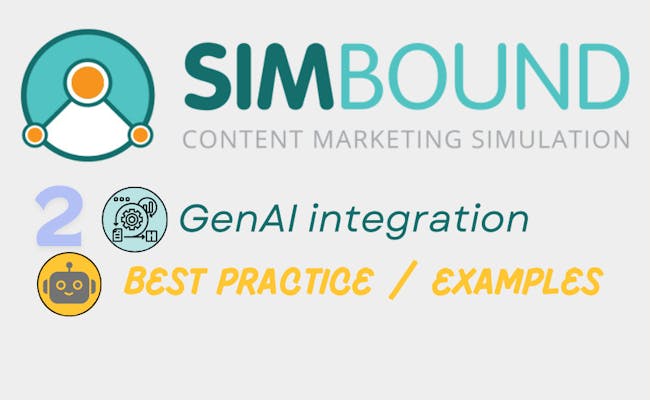How AI is used with the Simbound marketing simulation?
We outline some of the existing best practices, outline possible new research and development avenues and criticism related to Simbound and its incorporation of GenAI.

Introduction
The incorporation of Artificial Intelligence (AI) into simulations, which is a distinctive feature to the simulation approach, allows course instructors to choose the specific extent to which various generative AI and tools are part of the core learning experience. When deployed in conjunction with monitoring tools this can help identify and track the various decision-making styles of course participants and help reduce time consuming tasks such as sifting through results.
We should begin by saying that the majority of decisions in the Simbound simulation will not be aided or influenced by the use of Artificial Intelligence (AI) by default and it is up to each instructor to decide the extent to which AI will be used to carry out each of the simulation's learning activities.

By default, learners in Simbound can receive basic guidance from AI. This is optional, and students can choose whether to follow the advice they are presented with or not. The guidance often comes in the form of a short, relevant written recommendation. The system will also periodically check if the user inputs data and compares this to basic quality guidelines. Under one specific context, the results of the simulation will reflect unfavorably on repeated or overreliance on AI and other highly automated methods.
Additionally, the extent to which AI is accessed and used by each of the students whilst they are using Simbound is measured and as of February 2025 we are working together with a host of international academic partners to integrate the means for various longitudinal research on this topic to take place. One such goal for research is to determine whether learners who rely on AI will stand to become better/more successful marketing managers over time.
How learning is achieved by using AI with simulations
The effectiveness of the simulation-based approach is enhanced by one of its key features, which is that it facilitates the practice of a variety of skills, including those that are domain-transversal, i.e., skills that are applicable across all major sectors, such as services, manufacturing, and public policy. The use of simulations in nearly every major industrial and service domain helps to confirm what many of the academic research papers have uncovered along recent years when it comes to the positive impact of simulations on various outcomes related to learning and upskilling.
The modularity provided by AI learning companions provides, at a basic level, learners with quick analysis, advice or recommendations using a narrative approach, which is useful for individuals, especially catering to those with a diverse preference for learning methods. The nature and frequency of this generated feedback can and should be adjusted by instructors with each new course they teach. Instructors are aware that the use of AI powered services is an accurate representation of today's workplace, where multiple professionals, supported by various systems must work together to achieve tangible results. AI can help by suggesting new methods and new concepts to learn, and by highlighting concepts that students have not been able to demonstrate a good understanding of.
The Simbound simulation provides note-taking applications and learning tools to help students progress in their courses. These include quizzes and journals. These tools help students document their learning and share their knowledge. The end product of using these tools, typically short written reports, can then be fed into AI-designed tools that ultimately help students improve their skills and better achieve their learning goals with tailored recommendations and new sources of information, accelerating previous learning and research processes.

Criticism
Despite the several advantages associated with the implementation of AI in educational settings where simulations are used it is important to note that using a well-built simulation even in the absence of AI remains a viable pedagogical approach. Our current educational simulation framework at Simbound does not currently rely on AI as a central system component.
With the planning of each individual course, it is crucial to reflect upon the potential drawbacks associated with an over-reliance on AI. This has the potential to hinder learners’ progress towards autonomy and erode their capacity for independent decision-making, making way for a mindset akin to that of executive agents working on a very specific set of issues, rather than curious and enthusiastic learners and researchers with a broader view of the world. Just as importantly, AI can be perceived by some users as opaque, repetitive, and deterministic, making it difficult for learners to grasp the nuances required for sophisticated reasoning, and also making it difficult to practice working on complex tasks, some of which may not take place in the digital realm.
A more recent concern in the online advertising and social network industries is the resemblance of communications and visual assets which takes place along with the dissemination of uniform messages that can have minor variations across industries and brands. If not well designed, AI generated marketing materials may be perceived as a careless manipulation of the message and the messaging environment, going against what is best practice in online communications in general and leading to perceptions of amateurism or even repulse towards the initiators of messaging. This warrants extra consideration towards the implications associated with the exclusion or limitation of human-generated content from brand communications.
It would be wise to raise the potential issue of "content crowding," during the course. This occurs when content is either ignored or pushed to the bottom of discovery feeds due to a lack of engagement. The role of AI in causing content crowding is as of now emergent and not fully understood.
Given the current state of AI's prevalence, instructors may encounter challenges in grading students solely based on written content. One viable solution remains that to use simulations, which can provide insight into each student's current level of ability.
Best Practice
When setting up the course, it's essential to ensure that data sets are "clean" and well organized. This ensures that they can be interpreted by AI and treated without error or bias. Another challenge appears when students are setting out to manage too many products or customer segments through personalized marketing messages which can then become difficult to maintain for individuals or teams with a lack of time or skill in managing complexity. There is a real risk of harming the brand this way. For example, marketing departments can make promises using AI which the business cannot easily deliver. This could lead to perceptions of false or deceptive advertising.
As with any project undertaken for learning purposes that relies on technology, it is essential for students to understand that effective planning and acquiring precise information are pivotal to achieving success. Another key skill that can be practiced when using Simbound together with the in-built AI tools is the ability to make use of the latest educational technology and a host of various resources in a most effective manner in order to achieve specific goals, whether these goals are learning-related or more "transactional" in nature (e.g., obtaining certain financial results in the simulation). Wondering about how certain things work ‘behind the scenes’ can stir up curiosity and excitement.
Since simulations allow for the practice of a critical skill related to prioritization and managing complexity by providing tasks, time limits and peer demands the individuals that use them can help improve into becoming confident professionals who are ready to deal with the type of situations that can be found within the modern collaborative workplace.
It's important to consider how the integration of AI might be perceived as a sort of oversight in the development of the branding processes and choosing of the right communication tools. The choices made could potentially and ultimately influence how the audience perceives the brand, leading to it being viewed as a commodity rather than a valuable source of unique insights. In this regard AI content should be flagged and the percentage of AI generated content should be included in the final assessment of each students’ results in the simulation.
Further reading: Rohim Mohammed, a Lecturer at University College Birmingham relates his experience in teaching digital marketing with the Simbound simulation and AI
https://www.timeshighereducation.com/campus/transforming-marketing-lectures-ai-and-simulations
Looking into the future

In summary, the general pedagogical approach advocated for by the use of simulations such as Simbound together with AI fosters transparency, continuous and incremental experimentation and the acceptance of various errors in decision-making. AI is primarily utilized in time-consuming processes or those with lower educational value.
Within Simbound and other similar simulations, students either win or they learn. Errors in appraisal or in the execution of operations in this type of environment, where mistakes can be freely made without any consequence, will often turn out to be valuable learning experiences. These are there to equip students with the skills and competencies necessary to perform well in today's competitive job and entrepreneurial market.
